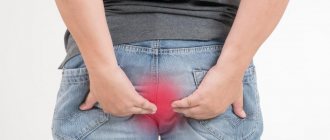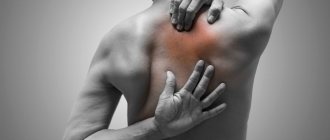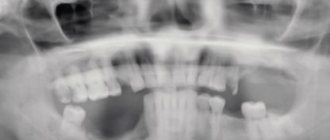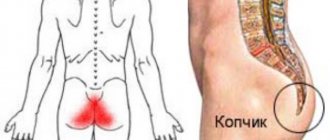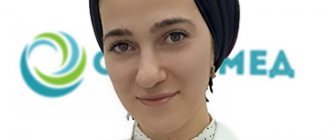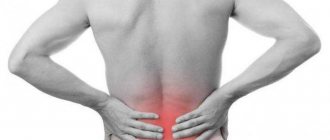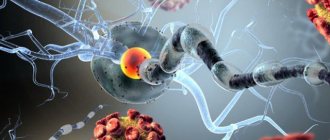Back pain is described in different ways: acute, nagging, excruciating, burning, paroxysmal, etc. The reasons that cause it also vary. Although, frankly speaking, most of us don’t bother looking for them. If you get sick, you need to apply heat and take a pill (give an injection).
But it's not that simple. Back pain can be either a consequence of an easily removable (if you are in the hands of a good specialist) muscle tension, or a manifestation of a very serious disease that needs immediate treatment. And the sooner a person starts therapy, the greater the chance of success.
Only a doctor can correctly determine the cause and nature of the pathology and prescribe adequate complex therapy! Self-medication for back pain is ineffective and dangerous!
What is sciatica
Radiculitis (radiculopathy, radicular syndrome) is an inflammatory lesion of the spinal roots, accompanied by severe pain.
In the public consciousness, this disease is inextricably linked with old age, which is generally true: according to statistics, every eighth person from the older age group suffers from acute or chronic radiculitis. However, people aged 30+ are not immune from this disease. We largely owe this “rejuvenation” of the disease to the increase in the number of office “sedentary” professions.
Pathological changes can occur in one spinal root or in several simultaneously.
1 Diagnosis and treatment of radiculitis
2 Diagnosis and treatment of radiculitis
3 Diagnosis and treatment of radiculitis
Treatment
Treatment of radiculitis by CELT specialists is successfully carried out using conservative and surgical methods. They can not only eliminate pain, but also reduce inflammation, relieve muscle spasms and free the roots from compression. The following methods are used for this:
| Methodology | Description |
| Treatment with medications |
|
| Limitation of physical activity |
|
| Manual therapy |
|
| Physiotherapeutic treatment |
|
| Surgical techniques |
|
A procedure such as a blockade, which is a special injection into the source of pain using local anesthetics and anti-inflammatory drugs, allows for an almost instantaneous effect that can last up to one year. It is achieved by introducing the drug into the affected area. In this case, the patient can go home on the same day and live a normal life.
Why do the spinal roots become inflamed?
Radiculopathy can be provoked by various reasons, but in the overwhelming majority of cases, the root of all ills is osteochondrosis and associated degenerative changes in the tissues of the intervertebral discs and vertebrae.
Other common causes of sciatica include:
- spinal tumors;
- abnormalities of the spine;
- traumatic injuries;
- spinal hernia;
- rheumatism, arthritis;
- overweight, low physical activity;
- constant static load on the spine (sedentary and standing work);
- compression loads on the spine (physically hard work and sports disciplines that involve lifting weights);
- infectious diseases (influenza, meningitis, tuberculosis, syphilis);
- frequent hypothermia, etc.
Causes
Radiculitis in the lumbar and sacral regions is not an independent disease. Various reasons lead to irritation and compression of the nerve roots, followed by serious discomfort. These may be introduced infections, but most often the development of osteochondrosis leads to radiculitis.
Spinal injuries
Injuries and bruises of the spine, which will subsequently lead to the development of radiculitis, are:
- serious intense impacts - car accidents, falls from a height, pressure from heavy objects (during the collapse of buildings, for example);
- physical impacts (impacts, collisions with other objects and people);
- injuries against the background of existing pathologies (osteoporosis, metastases, tumors, etc.): such trauma is possible even with an awkward turn in bed. You can also get injured while playing sports.
Disease, such as arthritis
Various diseases, mainly of the musculoskeletal system (arthritis, spondyloarthritis deformans, intervertebral hernia, osteoarthritis, etc.), can also lead to inflammation of the roots. Also, radiculitis can be a consequence and complication of diseases such as meningitis, influenza, rheumatism, tuberculosis, etc.
Osteochondrosis
Osteochondrosis
– one of the main reasons leading to radiculitis in the lower back. Pathology occurs due to various types of deformations of the spine and its individual parts. The main factor in the development of osteochondrosis is overload of the musculoskeletal system, which occurs due to poor posture, individual style of sitting or walking, heredity, abnormal development, inappropriate or excessive physical activity. Osteochondrosis of the lumbar region is often associated with overload when bending and lifting heavy objects.
Symptoms of radiculitis
Depending on the location of the inflammatory process, cervical, lumbar, and sacral radiculitis are distinguished.
The key sign of any radiculopathy is a sharp “shooting” pain. A person suffering from radicular syndrome is usually easy to recognize by his unnatural, stiff posture - this is how he instinctively seeks a position that minimizes pain. Numbness, tingling, decreased or loss of sensitivity in the affected area also indicate an attack of radiculitis.
1 Treatment of radiculitis
2 Diagnosis of radiculitis: EMNG
3 Diagnosis of radiculitis: ENMG
Cervical radiculitis is characterized by pain and sensory disturbances in the back of the head, back of the head and shoulders. The sensations intensify when moving the head (nodding, bending, turning). The patient may experience torticollis.
With cervicobrachial radiculitis, pain and numbness in the shoulders, shoulder blades, and arms are added to the listed symptoms; with cervicothoracic - pain in the upper part of the thoracic back.
Thoracic radiculitis manifests itself as severe pain in the chest, cardialgia (pain in the heart), shoulder girdle and intercostal space, as well as in the abdomen. Aching paroxysmal pain with radiculitis of this type is accompanied by tingling and numbness and can radiate to the arms. A person’s body temperature may drop, blood pressure may rise, and difficulty breathing may occur.
Lumbosacral radiculitis (lumbar sciatica) is the most common type of disease that involves the lumbosacral joint. It manifests itself as acute pain in the lumbar region, radiating to the leg (both along the front and back surfaces). The pain extends below the knee and reaches the lower leg and foot, accompanied by impaired walking, difficulty bending, unpleasant numbness and tingling of the leg. Over time, muscle atrophy may occur.
Due to its mobility, the lumbar region is often subject to injury. This part of the spine is characterized by pathologies such as disc herniation, osteochondrosis, and spondyloarthrosis.
As a result of compression of the roots of the lumbar region, acute pain appears, radiating to the buttock, thigh, lower leg and outer part of the foot. When moving, the sensation intensifies, and the person may limp.
Lower back pain is not always a manifestation of lumbosacral radiculitis; it can be other diseases of the spine.
1 Diagnosis of radiculitis: MRI of the spine
2 Diagnosis of radiculitis: EMNG
3 Diagnosis of radiculitis: ENMG
Lumbago
Lumbago (“lumbago”) may or may not be associated with radiculopathy. The disease is characterized by sudden intense (shooting, tearing, pulsating) pain in the lower back, muscle spasms and movement disorders. The pain may radiate to the buttock or leg.
The pain can persist for a long time, up to a month.
Lumbodynia (lumbago pain) can occur due to severe hypothermia, significant stress, or traumatic displacement of the vertebrae.
An attack of lumbago, on average, lasts up to 5-7 days. According to patients, lumbodynia is most severe in the first hours of an attack and at night.
Treatment of lumbago at home should be limited to pain relief, then you should urgently visit a neurologist.
With proper treatment, complete recovery (with the disappearance of all manifestations of lumbago) occurs within 1-1.5 months.
Sciatica
Sciatica is accompanied by sharp, burning pain along the sciatic nerve. Therefore, another name for this disease is often used - sciatic nerve sciatica . There may be no lower back pain with sciatica.
The symptoms of sciatica are limited mainly to one word - pain. Pain with sciatica is described by patients as shooting, burning, dagger-like. They can be either paroxysmal or very long-lasting, chronic.
Pain with sciatica is usually one-sided. They can cover the buttock, the back of the thigh and lower leg, sometimes reaching the fingertips. Symmetrical pain is a fairly rare occurrence.
Sciatica
With lumbar sciatica the symptoms of lumbago and sciatica are combined and concentrated in the lumbar region, moving to the buttocks and legs. The pain is described as long lasting and deep.
Diagnostics
For the diagnosis of radiculopathy, the presence of tension symptoms is important. For example, Lasegue's symptom is typical - when you try to raise a straight leg while lying on your back, pain in the lower back increases.
An MRI or CT scan of the lumbosacral spine is important for making a correct diagnosis, because only these studies will allow the attending physician to identify the presence of diseases such as intervertebral hernias or other diseases of the spine (spondylitis, compression fractures, neoplasms).
Acute and chronic forms of pathology
Experts distinguish acute and chronic forms of pathology. Failure to see a doctor in a timely manner or self-treatment can lead to acute radiculitis becoming chronic. As a result, restoring health will require more time and effort.
Patients seek medical help in most cases due to severe pain and limited movement characteristic of the acute form. In the chronic form of radiculitis, the pain can be constant and dull, so patients often prefer the option of treating radiculitis at home with folk remedies, which is fraught with serious complications. Experts recommend seeking medical help at the first signs of radiculitis.
How to make an appointment with a neurologist
JSC "Medicine" (clinic of academician Roitberg) in Moscow offers European-level services for the diagnosis, treatment and prevention of radiculitis. To receive highly qualified medical care, you must make an appointment with a neurologist who will conduct an examination and a comprehensive medical examination.
To make an appointment with a specialist, use one of the following methods:
- quick registration form on the main page of the clinic’s website;
- by phone 24 hours a day +7 (495) 775-73-60;
- using a mobile application.
JSC "Medicine" (clinic of academician Roitberg) is located in the center of Moscow at 2nd Tverskoy-Yamskaya lane, 10, a five-minute walk from the Mayakovskaya metro station.
JSC "Medicine" (clinic of academician Roitberg) in Moscow also offers emergency call services around the clock by calling +7.
Surgical intervention
Operations for diseases of the spine
- Cost: 100,000 - 250,000 rubles.
- Duration: 40-60 minutes
- Hospitalization: 2-3 days in hospital
More details
Surgical intervention is carried out exclusively according to indications:
- lack of effect from conservative treatment;
- inhibition of tendon reflexes;
- feeling of weakness in the lower limb;
- decreased sensitivity of the lower limb.
Neurosurgeons at the CELT multidisciplinary clinic perform gentle operations through micro-incisions or punctures while preserving all supporting structures of the spine. Three-dimensional modeling of the operation and planning of each stage are carried out in advance. The process uses microsurgical and endoscopic techniques, laser and ultrasound, which allows our patients to quickly recover and return to work within two to three weeks after surgery.
When to see a doctor
If symptoms of radiculitis occur, you should consult a neurologist whose specialization is the diagnosis and treatment of diseases of the nervous system (central and peripheral). In some cases, an effective treatment for lumbar radiculitis can be offered by a therapist, but this option is only possible if it is not possible to consult a neurologist. The neurologist will determine the cause of the disease and take measures to eliminate them, prescribing an effective course of treatment.
Patients seek help most often in cases where lumbar radiculitis, the symptoms of which are described above, is acute.
In order to reduce pain and get effective help, it is enough to make an appointment with a neurologist at Meditsina JSC (academician Roitberg’s clinic) in the center of Moscow.
The pain treatment center of JSC "Medicine" (academician Roitberg's clinic) has modern diagnostic and medical equipment and a comfortable hospital. The clinic’s specialists use effective programs for the treatment, therapy and prevention of neurological diseases. The clinic's doctors widely use modern methods of physiotherapy. Contacting a clinic provides an opportunity to reduce the likelihood of developing radiculitis and avoid the consequences of the disease becoming severe.
